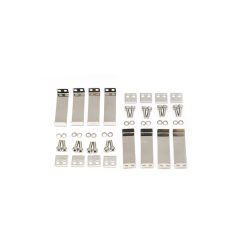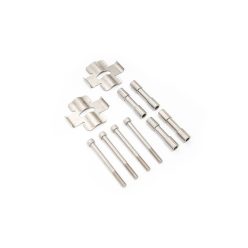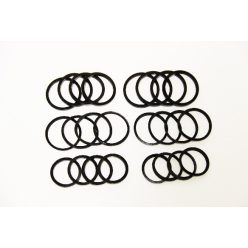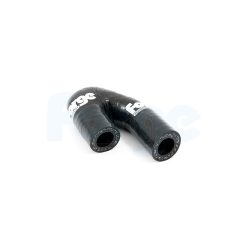Our Brake Components category focuses on Forge Motorsport parts for performance brake systems: standalone 6-piston calipers, 330/356 mm carriers, piston and seal kits, hardware kits, vacuum hoses and clamps. These specialised brake components are ideal for servicing, upgrading or repairing existing big brake kits when OE brakes are no longer sufficient for track days, tuned engines or intensive fast-road use.
Net price: 593 €
Net price: 41 €
Net price: 34 €
Net price: 50 €
Net price: 42 €
Net price: 22 €
Net price: 35 €
Net price: 135 €
Overview and Main Advantages
Brake Components brings together individual parts for high-performance and motorsport brake systems. Here you will find 6-piston Forge Motorsport calipers for 330–356 mm setups, matching carriers, piston and seal kits, pad hardware, as well as brake vacuum hoses and clamp kits. Instead of buying a complete big brake kit every time, you can replace or upgrade specific core components as they wear or when you want to adapt an existing system to new requirements.
Compared with full BBK packages, this category offers targeted service and upgrade parts: individual 6-pot calipers in yellow or black finishes, separate 356 mm carriers, piston and seal kits for 4- and 6-piston calipers, pad retainer and slider pin kits, hardware packs and dedicated vacuum hoses with optional clamp kits. This allows you to refresh a hard-worked brake setup, repair accident damage or fine-tune your system without replacing everything from discs to lines in one go.
Technical Basics
The 6-piston brake calipers found in this category are designed for use with large-diameter 330–356 mm rotors to provide higher thermal capacity and stronger torque. Multi-piston fixed calipers spread clamping force more evenly across the pad surface, helping to prevent localised hot spots and tapered rotor wear. Staggered piston diameters such as 30–36–38 mm or 32–36–38 mm are chosen to optimise pad loading and pedal feel, reducing the tendency for the leading edge of the pad to overheat or wear prematurely.
Dedicated piston kits and seal kits are available for both 6-pot front and 4-pot rear calipers, with combinations like 28–32 mm and 28–28 mm to match specific rear applications. These include pistons, dust boots and internal seals, allowing a full strip and rebuild of calipers that have seen heavy track duty or age-related degradation. Replacing worn seals and pitted pistons restores consistent hydraulic performance, cures sticking pistons and extends the service life of expensive forged caliper bodies.
In addition to the hydraulic parts, the category includes hardware kits such as pad retainers, slider pins and bolt sets for 6-piston calipers. These seemingly minor pieces are vital for quiet, reliable operation: worn or corroded pad hardware can cause rattles, uneven pad movement and ultimately irregular wear or noise. Finally, model-specific brake vacuum hoses and clamp kits—such as those for Audi TT, S3 and SEAT Leon Cupra—ensure the brake booster receives a stable vacuum supply, which is crucial for consistent pedal effort and servo assistance.
Selection Criteria
Before ordering brake components, it is essential to know exactly which system you are working with: OEM, a specific Forge Motorsport BBK, or a custom hybrid setup. Standalone 6-piston calipers and 356 mm carriers are usually designed to match particular Forge big brake kits, so you should confirm rotor diameter, offset and mounting bolt pattern, as well as the minimum wheel size required to clear the caliper. On a car that already runs a Forge kit, items in this category are generally direct-fit service parts; on bespoke builds, sizing and compatibility should be checked by an experienced technician.
When choosing seal and piston kits, pay close attention to the piston diameter combinations listed for each part number. An incorrect combination can alter brake balance or lead to abnormal wear. Always match the kit to the caliper type (front 6-pot or rear 4-pot) and verify the dimensions against the product description. Pad hardware kits are a smart choice whenever you replace calipers or pads on a high-mileage system—fresh retainers and pins help the pads move freely and seat properly under load, improving both noise behaviour and bite consistency.
For vacuum hoses and clamp kits, look for vehicle-specific listings where available. Universal hoses must be carefully selected in terms of internal diameter, heat rating and oil resistance, especially on turbocharged engines where vacuum routing can be complex. If the car has undergone engine or turbo upgrades, it is critical that the brake servo’s vacuum line is not an afterthought; a correctly specified hose and clamps are essential for reliable brake booster performance under all conditions.
Installation & Maintenance
Working on brake components—particularly calipers, pistons and seals—is safety critical, so professional installation is strongly recommended. When fitting calipers and carriers, mounting surfaces must be clean and flat, and all bolts torqued to the manufacturer’s specifications using a calibrated torque wrench. After installation, rotor-to-caliper alignment and pad clearance should be checked to ensure there is no binding or uneven contact, which can cause vibration, pulling or premature wear.
During a caliper rebuild, it is good practice to fully strip and clean the body before fitting new pistons and seals. Use only brake-fluid-compatible cleaners and lubricants on sealing surfaces; harsh solvents or abrasives can damage bores and sealing lips. Once reassembled, bleed the system thoroughly and test pedal feel and brake balance at low speeds in a safe area before returning the car to full performance use. Any signs of leakage, dragging or inconsistent response must be addressed immediately.
When replacing vacuum hoses and clamps, route hoses so they do not kink, chafe on sharp edges or rest against hot components like manifolds and turbo housings. Loose clamps can allow air leaks that reduce servo assistance and increase pedal effort; periodically check hose condition for cracking, soft spots or oil saturation and replace suspect sections before they fail. For cars used regularly on track or in drift events, integrate visual inspection of calipers, pistons, seals, hoses and hardware into your routine pre- and post-event checks.
FAQ
When is it better to buy individual brake components instead of a full BBK?
If you already have a Forge Motorsport or similar big brake kit installed and only a caliper, piston or seal has failed or worn, replacing just that component is usually the most cost-effective solution. A complete kit makes more sense when upgrading from stock brakes or when multiple major parts are damaged.
How do I know if I need a piston and seal kit?
Symptoms such as fluid leaks, torn dust boots, uneven pad wear or sticking pistons all point towards the need for a rebuild. In these cases, a dedicated piston and seal kit gives a more reliable result than trying to replace only one or two individual seals, especially on high-performance multi-piston calipers.
Can I replace only one front caliper on a big brake setup?
For safety and consistency, it is generally best to replace or rebuild calipers in pairs on the same axle, particularly if you are changing to a different generation or variant. If you rebuild one caliper, you should at least inspect and, if needed, refresh the other side to keep left-right behaviour closely matched.
Why is a dedicated brake vacuum hose so important?
The brake booster depends on a reliable source of vacuum delivered through a properly specified vacuum hose. Generic hoses that are not rated for heat, vacuum and oil exposure can soften, collapse or crack, leading to a hard pedal and reduced braking assistance—especially risky during repeated hard stops.
How often should performance brake components be inspected on a track car?
On cars that see frequent track days or drift events, key brake components such as calipers, seals, pistons, vacuum hoses and hardware should be inspected after each intensive outing. Any signs of discolouration, cracking, leakage or excessive wear warrant proactive replacement rather than waiting for a failure during the next event.











